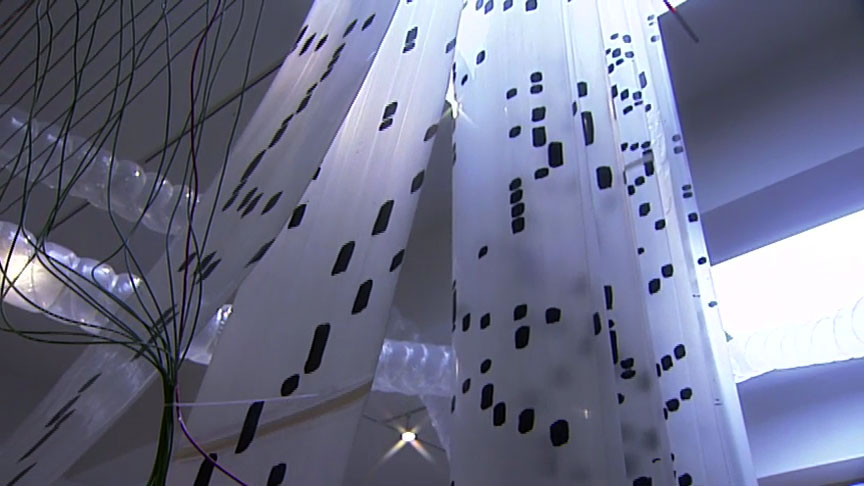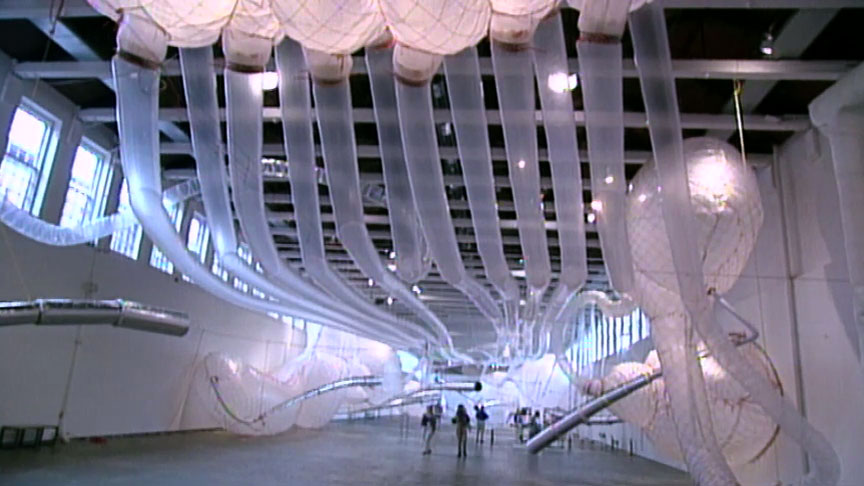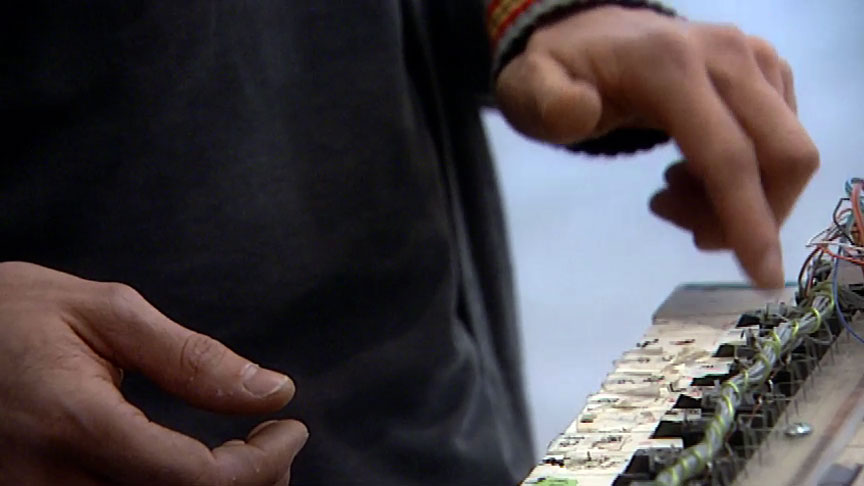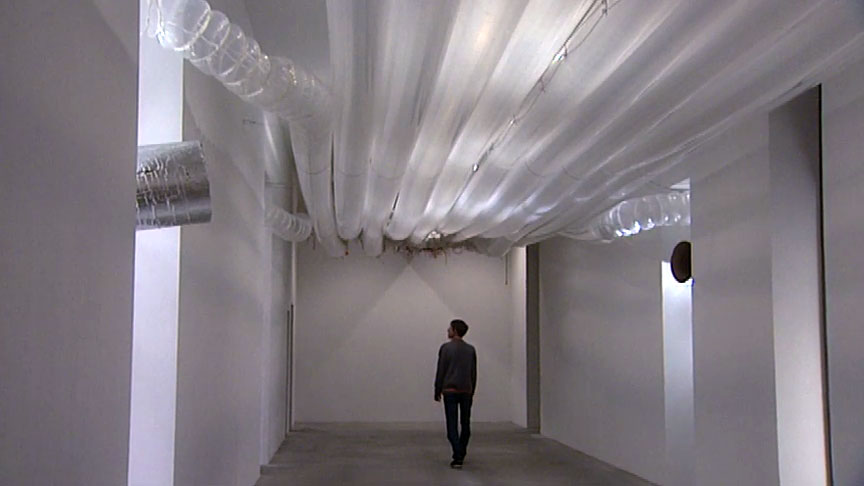Interview
“Überorgan”

Tim Hawkinson, Überorgan (2000), installed at Ace Gallery, New York, 2002. Production still from the Art in the Twenty-First Century Season 2 episode, Time. © Art21, Inc. 2003.
Artist Tim Hawkinson discusses his 2000 installation piece Überorgan, and the challenges of installing it in multiple locations.
ART21: Can you tell me about the process of making Überorgan?
HAWKINSON: Well, there isn’t really a set process. Lately the pieces have been all different from each other, so each one takes on a different process. Like, with the larger-scale pieces, it’s often the case where I don’t even have an idea for something of this size unless there’s already a venue set up for it. I would have a specific space in mind already, and I start visualizing the work in that space. I’m talking more about the Überorgan, specifically. That process involved being approached by MASS MoCA, and they wondered what I would do with a space that was basically the size of a football field. Using inflatables is really an economical way of filling up that much space and also something that makes sound to really engage the viewer. So, I came up with this extrapolated organ and went from there. It just seemed really natural for that space.
But other pieces involve more of a quirky kind of process, especially depictions of the body. For instance, there was a series of works that I did based on research that involved taking a bath in this black paint—filling the bathtub slowly with this black opaque liquid that would block out my skin. And Patty would photograph it every couple of seconds as it crept up and covered me over. Then, layering the photos together resulted in this kind of topographical depiction of the body. And so, I used that mapping as the basis for some drawings that I made and also realized three-dimensionally in the figures that are in the piece Pentecost, the big tree piece with the figures tapping on the tree.
ART21: Did you have to invent things to make it possible to make Überorgan?
HAWKINSON: Yeah, when I first started thinking about Überorgan and putting it in the space at MASS MoCA . . . I just said that I never make preliminary studies or anything, but I did make models of balloons. and I think I was just a little nervous about filling—what was it—fifteen thousand square feet. I didn’t want to get caught shorthanded. So, I felt much better seeing these little models in the space and having a basic idea of what it would feel like in there. So, I made really basic shapes and then really crude drawings or patterns of the shapes. It’s good that they were so crude because it really allowed for a lot of play in the actual fabrication when we started sewing them together. I mean, these balloons are huge, like the size of a small school bus. To sew them, there was one person on the sewing machine and two other people that were there just to feed the material through. There was a lot of mass to deal with just in their un-inflated state.
So, going back to using models and making little drawings based on those—what I conceived the patterns would be like . . . It’s taking a little bit of a jump because you’re taking a three-dimensional model and thinking about it in terms of planes and how you could make that just in flat surfaces that are then bent around each other. I really like the feel of and the look of the bags, the balloons being constrained by netting. That was really part of the process of creating the shapes. Once the bags were sewn and inflated, I used fishing net and tailored that around the balloons, and I was able to further define and cinch them in and let them out in different areas. So, it was neat. It was a really quick way of controlling a huge volume, a physical volume.

Tim Hawkinson. Überorgan (2000), installed at MASS MoCA, North Adams, MA, 2000. Production still from the Art in the Twenty-First Century Season 2 episode, Time. © Art21, Inc. 2003.
ART21: But did you have to invent tools for yourself?
HAWKINSON: Not for the balloons, maybe for some of the mechanical things. The balloons were all made with a fabricator, outside of my studio. You saw pictures of the studio; it’s not super huge. We needed, you know, thousands of square feet. So, I did all of the mechanical work in my studio—the player mechanism and different switches that reinterpreted the score and so forth.
ART21: Tell me about the sound in Überorgan.
HAWKINSON: For Überorgan, I felt that I was going to have a real strong physical presence, but I felt like it needed to also have this kind of audible component. They look like these, kind of, whales suspended in the air and hovering about you. And the sound is really biomorphic and sounds kind of like a bleating or a whaling sound. But it’s all based on a score that I put together, using lots of old church hymns. I have to refresh my memory—what did I use?—“Sailor’s Hornpipe” and “Swan Lake.” And there was an improvisational piece that I invited a guest composer in for—a friend that just kind of messed around with the keyboard. So, there was this score. And then it’s constrained to just a scale of twelve tones. You’re used to hearing a melody played in something that reaches up into other octaves. But in this case, anything that would go up into the next octave has to drop back down, and it further abstracts the original score and removes it further from certain recognizable melodies. So, then there were also a series of switches that filtered or reinterpreted the initial score.
ART21: Where does the interest in music come from?
HAWKINSON: Using the hymns . . . I did grow up going to church. I still go to church. We’re trying to find a church that we like in the area but are having a little bit of a problem finding something that really feels right. I grew up hearing these old Protestant hymns, and some of them are really beautiful, and they bring really strong connotations and memories back and also reflect faith and other issues. I was interested in using those, but really directly. Like I said, it’s really hard for most people to even recognize them. I can kind of catch passages, and I get an idea of where we are in the score. I was interested in using some of that as material. I mentioned earlier that the switches reinterpret the score. One would kind of flip-flop the orientation of the notes to the keyboard, so that what’s normally played at the high end is played at the low end. Another switch is the key that it’s played in. All these switches are being activated, kind of spontaneously, just by viewers going through the space, so there’s no telling when it’s going to shift. And so, it really is played out a different way each time someone passes through.

Tim Hawkinson. Überorgan (2000), installed at Ace Gallery, New York, 2002. Production still from the Art in the Twenty-First Century Season 2 episode, Time. © Art21, Inc. 2003.
ART21: And you can also play it, right?
HAWKINSON: Yeah, you can also stop the playing score at a blank space to expose the keyboard. The keyboard consists, basically, of these photosensitive switches. So, by covering one of the switches, blocking out the light, you’d trigger one of the notes. So, you can stop it at a blank space and play it like a piano, like a light-sensitive piano.
ART21: Were you fascinated by doing a piece out of air, or was it just economy?
HAWKINSON: Well, using the materials, just these thin membranes filled with air—it had a very attractive quality for me. Thinking of sculpting with air. In a lot of my work, I use transparent materials, especially in mechanical pieces, because I like to be able to see what’s going on and keep everything very light and visible. This had kind of an ethereal quality that really appealed to me. And also, it was a really economical way of filling the space. And I liked the idea of traveling light—this thing that could really go up in a week, and it’s just so expansive and organic also.
ART21: What about the adaptability of Überorgan, how it changes from place to place?
HAWKINSON: I was actually thinking about this last night because I’m going to be installing Überorgan again, this time in San Diego. And it’s a smaller space. I was thinking about how I’m going to be dealing with this big installation piece for some time, and it’s going to be important to keep it alive to myself and be able to see it as a new thing each time it’s set up. And so, I think it’s really good that it can be reconfigured, and it just naturally extends to being reconfigured into each different space because of the different physicalities of different venues. I’d like to see it in more of a square, really symmetrical space—more of a classical setting for it. And also, I think it would be interesting to use it more vertically, in a really vertical space.
ART21: Tell me about the installation in New York.
HAWKINSON: When I installed the piece in New York, the gallery was obviously really different from MASS MoCA, which was one big, open space—one long, narrow space. The gallery in New York was divided into six rooms: one gigantic room, and a couple of giant rooms, and then some slightly smaller rooms, but they are all pretty big. But I wanted to see it as this thing that was growing into the different gallery spaces—real biomorphic, in that way. I was afraid that the sound quality might be lost, that you might lose a sense of the score because it was divided up into the different rooms. But in the end, I was really happy with the sound. There are so many reflective surfaces in that space that when you’re out in the hallway, you can still hear the further reaches and put things together. But it was definitely different than in Massachusetts.

Tim Hawkinson. Überorgan (2000), installed at Ace Gallery, New York, 2002. Production still from the Art in the Twenty-First Century Season 2 episode, Time. © Art21, Inc. 2003.
ART21: Did it take a lot of planning?
HAWKINSON: In New York, I had already made the model that I had talked about, and I felt confident just in occupying the space, and I didn’t want to think about it too much. I wanted to just really remain blank, to be able to play around with it and be spontaneous with the installation. So, I didn’t do a lot of preliminary thinking about placement. I had a general idea what balloon went into what gallery, and there were a couple of instances where I shifted things around but pretty much stuck with the original plan. Installing the tubes and stuff like that goes pretty fast. In the New York installation, I ended up wrapping all the tubes with tape. Normally the tube, when it’s inflated, is really rigid, and it just goes in a straight line; or if it does bend, it makes a ninety-degree bend, a really sharp bend. And I wanted the tubes in this New York space to curve around and play off of the rectilinear architecture. So, by wrapping the tube with this kind of strapping tape, it gave it a kind of intestinal quality and snaking, so they bent very gracefully.
ART21: It’s a very organic piece, alive even.
HAWKINSON: Yeah, I think it’s organic. There’s an organic aspect in much of my work that maybe has to do with keeping the rules really open. There’s this handheld, handmade aspect in a lot of the work that just by nature creates it’s own signature, creates these kind of organic references. It’s not something that I’m really trying to go after. It’s sort of by-product, I think.
This interview was originally published on PBS.org in September 2003 and was republished on Art21.org in November 2011.



